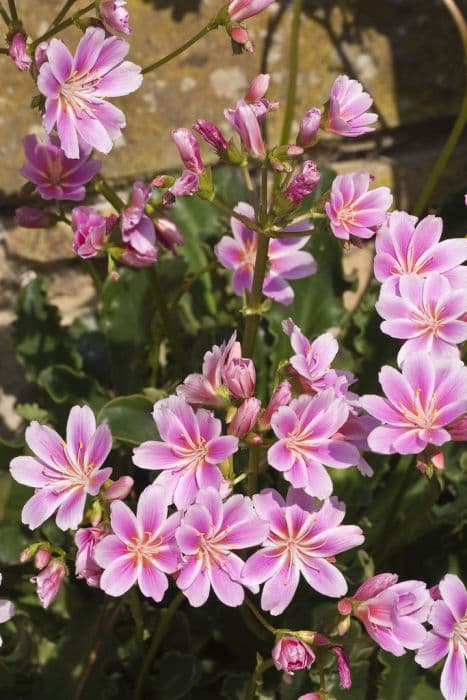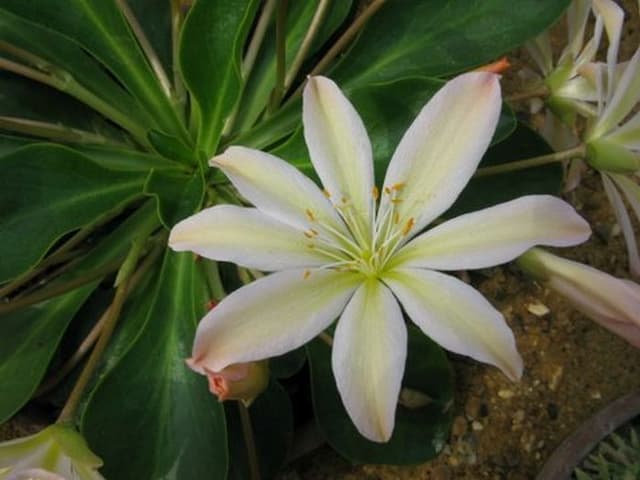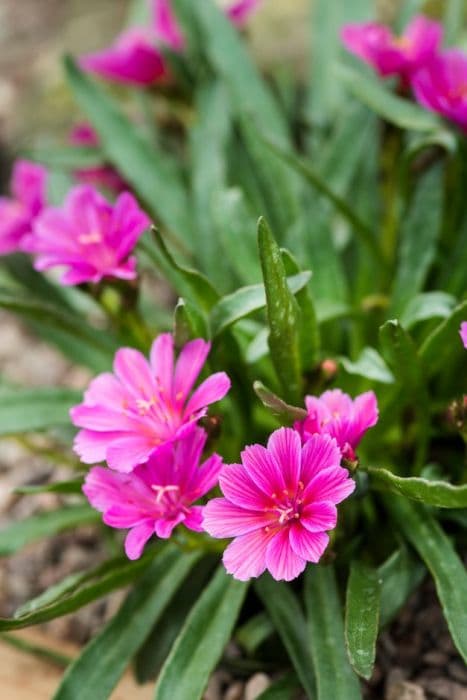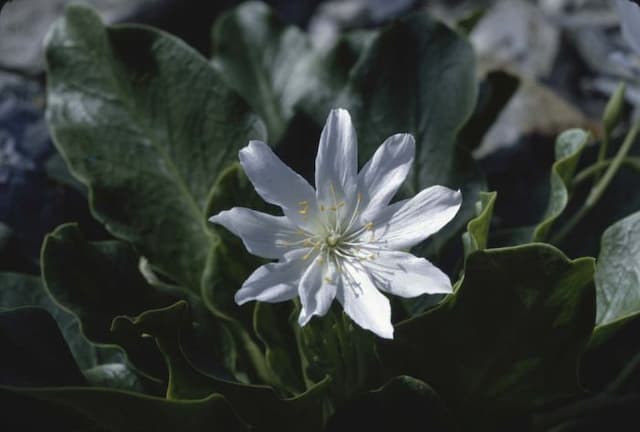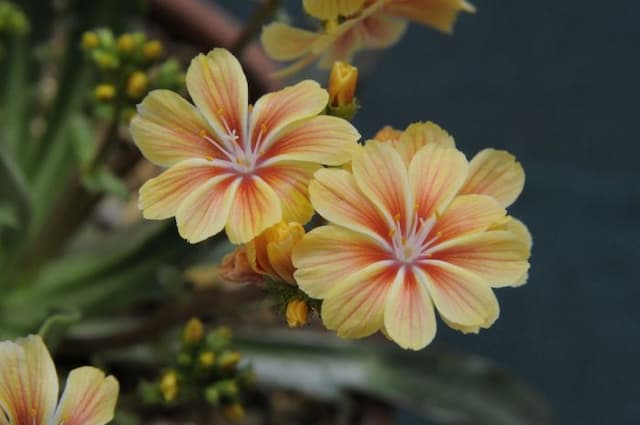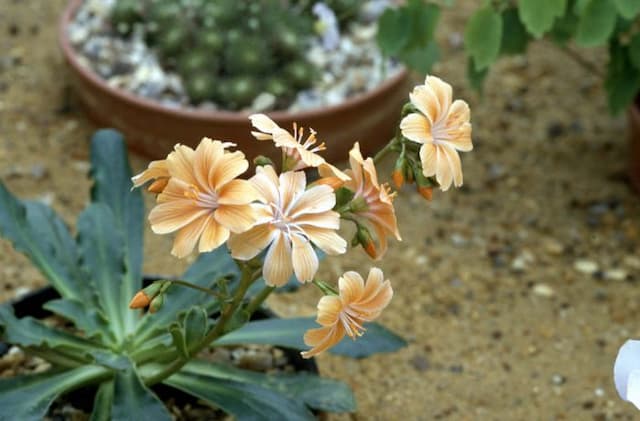Short-sepal bitter-root Lewisia brachycalyx

ABOUT
L. brachycalyx is a deciduous, tufted perennial to 8cm in height, forming a rosette of narrow fleshy dark green leaves, with solitary white or pale pink flowers 3-5cm in width, borne just above the foliage
About this plant
 Names
NamesFamily
Montiaceae
Synonyms
Short-sepal Lewisia
Common names
Oreobroma brachycalx
 Characteristics
CharacteristicsLife cycle
Perennials
Foliage type
Evergreen
Color of leaves
Green
Flower color
Pink
Height
0.5 feet (15 cm)
Spread
1 feet (30 cm)
Plant type
Herb
Hardiness zones
5
Native area
North America
Benefits
 General Benefits
General Benefits- Erosion Control: Lewisia brachycalyx has a rooting system that helps stabilize soil and prevent erosion.
- Drought Resistance: This plant is well adapted to survive in dry conditions, requiring minimal water once established.
- Aesthetic Appeal: With its attractive flowers, Lewisia brachycalyx adds color and beauty to gardens and rockeries.
- Wildlife Habitat: It provides nectar for pollinators such as bees and butterflies, playing a role in local ecosystems.
- Low Maintenance: Due to its adaptability to poor soil and drought, it requires little care, making it ideal for low-maintenance landscaping.
- Alpine and Rock Gardens: It is particularly suited for alpine and rock gardens, where its compact size and floral display are valuable attributes.
 Medical Properties
Medical PropertiesThis plant is not used for medical purposes.
 Air-purifying Qualities
Air-purifying QualitiesThis plant is not specifically known for air purifying qualities.
 Other Uses
Other Uses- Lewisias, including Lewisia brachycalyx, are sometimes used as a natural dye for fabrics, where the color can vary depending on the part of the plant used.
- In rock gardens, they serve an aesthetic purpose, adding a splash of color with their blooms in rocky or alpine landscaping.
- Lewisias are sometimes featured in botanical art and photography due to their unique and vibrant flowers.
- The flowers of Lewisia brachycalyx can be used as edible garnishes for salads and desserts, adding a delicate and colorful touch to dishes.
- Lewisias have been used in traditional Native American decorative arts, especially in basket weaving for adding natural dyes and patterns.
- In folklore, Lewisia brachycalyx has been associated with good luck in gardens, and planting them is believed by some to protect other plants.
- The plant can be utilized in educational settings, such as botany and horticulture programs, for teaching about alpine plant adaptations and cultivation techniques.
- Beekeeping enthusiasts sometimes plant Lewisia brachycalyx to attract and support local bee populations due to their nectar-rich flowers.
- They can be used in xeriscaping, a landscaping method that reduces the need for irrigation, due to their drought tolerance.
- Lewisias can be used in container gardening, making it easier for gardeners with limited space to enjoy their beauty.
Interesting Facts
 Feng Shui
Feng ShuiThe Lewisia brachycalyx is not used in Feng Shui practice.
 Zodiac Sign Compitability
Zodiac Sign CompitabilityThe Lewisia brachycalyx is not used in astrology practice.
 Plant Symbolism
Plant Symbolism- Tenacity: Lewisia brachycalyx, also known as Bitterroot, commonly symbolizes tenacity due to its ability to thrive in rocky and challenging terrain.
- Survival: Its capability to survive in poor soil conditions and dry areas makes Bitterroot a symbol of survival and endurance.
- Adaptability: Bitterroot's adaptation to its environment represents flexibility and the ability to thrive in various conditions.
- Connection to Native Culture: Native American tribes have historically used Bitterroot, so it holds cultural significance and symbolizes a connection to tradition and the land.
- Beauty in Harshness: The delicate beauty of Bitterroot flowers amidst rugged terrains symbolizes the presence of beauty and hope even in harsh circumstances.
 Water
WaterShort-leaved Lewisia requires careful watering to prevent root rot while ensuring the soil doesn't completely dry out. During the growing season, water thoroughly when the top inch of soil feels dry, approximately once or twice a week, with about 16 ounces of water each time. In winter, reduce watering to every few weeks, ensuring the soil is mostly dry before adding water. Do not let water sit in the rosette of the plant as this can cause disease.
 Light
LightShort-leaved Lewisia thrives best in bright, indirect light and can tolerate some morning sun. A spot that receives filtered sunlight or a little shade during the hottest parts of the day is ideal. Avoiding intense afternoon sun prevents leaf scorch and helps maintain vibrant foliage color.
 Temperature
TemperatureShort-leaved Lewisia prefers moderate to cool temperatures, thriving between 40°F and 75°F. It can survive brief periods of colder temperatures down to 20°F but should be protected from prolonged freezes. During hot summers, it's essential to provide extra shade to keep the temperature within the ideal range.
 Pruning
PruningShort-leaved Lewisia benefits from light pruning to remove spent flowers and encourage further blooming. Pruning is also necessary to remove any damaged or diseased foliage. The best time for pruning is immediately after the main bloom cycle, typically in late spring or early summer, to prepare the plant for potential secondary blooms.
 Cleaning
CleaningAs needed
 Soil
SoilThe best soil mix for Lewisia brachycalyx, commonly known as Short-sepaled lewisia, should be well-draining and gritty with a slightly acidic to neutral pH range of 5.5 to 7.0. A mixture of potting soil, coarse sand, and fine pumice or perlite in equal parts is recommended to provide the right balance of drainage and moisture retention for this alpine plant.
 Repotting
RepottingShort-sepaled lewisia does not require frequent repotting and can be repotted every 2-3 years or when the plant visibly outgrows its container. It's best to repot in the spring just as the plant is coming out of dormancy and before the growing season begins.
 Humidity & Misting
Humidity & MistingShort-sepaled lewisia prefers moderate humidity levels, as conditions too damp can lead to rot. Aim for humidity levels between 40-50%, which are typical of many indoor environments, to keep this plant healthy without the need for extra humidity measures.
 Suitable locations
Suitable locationsIndoor
Grow Short-sepaled lewisia in bright light, well-draining mix, moderate humidity.
Outdoor
Place Short-sepaled lewisia in full sun to part shade, rocky soil.
Hardiness zone
4-8 USDA
 Life cycle
Life cycleLewisia brachycalyx, commonly known as the short-sepaled lewisia, begins its life as a seed that germinates when conditions are optimal, usually in damp, well-draining soils. After germination, it develops a rosette of fleshy, evergreen leaves from which a flower stalk emerges, typically in late spring to early summer. The flowers of the short-sepaled lewisia are distinctive, with pink to white petals often marked with darker veins, and once pollination occurs, these flowers will develop into fruit capsules. Seeds are dispersed from the mature capsules, spreading to new locations where they can germinate. Being a perennial, the plant will go into dormancy in the late fall and winter, withdrawing energy back into its tuberous root to survive the cold. With the return of favorable conditions in the spring, Lewisia brachycalyx will break dormancy, resuming growth and completing its life cycle annually.
 Propogation
PropogationPropogation time
Spring-early summer
Propogation: Lewisia brachycalyx, commonly known as the Short-sepal lewisia, is often propagated through seed sowing. The most popular method to propagate this mountainous perennial is by sowing its seeds directly into the soil. This is typically done in the fall to allow the cold season to stratify the seeds naturally, enhancing germination that occurs in the spring. To sow seeds, they should be lightly covered with a fine layer of soil or vermiculite. The seeds require well-draining soil and should not be kept too wet to prevent rot. It is essential to provide a cold period, either through natural outdoor temperatures or by artificial stratification in a refrigerator, approximately 4 degrees Celsius (39 degrees Fahrenheit), for a few weeks before expecting germination. Seedlings usually appear with the warming temperatures of spring.
